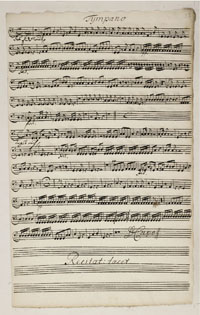HIP hip
November 2009
"The man who looks for
security, even in the mind, is like a man who would chop off his limbs in order
to have artificial ones, which will give him no pain or trouble."
~Henry
Miller
Welcome, or welcome back to
the avant garde of "Historically Informed Performance" (HIP). Avant
garde a clue what this means?
HERE, you can read about our performance decisions. We feel that such things are important, allowing us to play to you with a clear conscience and an open
heart. You won't hear an imitation of a recent "perfect" CD recording - this is
a season of premieres after all! Our intention is that, if
you close your eyes and forgive the offstage tram bells (roughly pitched at our
a'', you can imagine you've been transported back nearly
300 years to the original premieres, without the smell.
In this programme, the text and affects mainly express the
doom and gloom of an approaching winter. So, if you feel a bit sad, it's
working! Please allow these negative feelings to leave and, when you leave, you
can further lighten your burden by donating generously to the collection......
Last month, you heard the
rare combination of timpani and horns - timpani were usually associated with
trumpets in the Baroque era. This month, Grapuner's cantata Das Ende kommt,
der TodTod has an orchestration that could well be unique:-
  Where to start?
Where to start?
The use, with strings and voices, of natural brass (two horns, one trumpet) pitched in F
(12'), G (102/3') and C (8'), respectively, is, to our knowledge,
the only extant example from the 18th century.
Graupner's scoring is contemporary and experimental yet harks back to the fanfare/ritornello styles
of his predecessors, whilst being ominously prophetic of how, in the later 18th
century, writing for brass instruments made fewer demands on players'
virtuosity in the high register. Using only "safer" notes and a bit of imagination,
Graupner was able to explore his harmonic palette and create some very
interesting effects.
And then there's the
Timpani!
The part was written for Johann SchŸler, who
must have been pretty nimble. Graupner wrote one piece for him that uses eight
timpani. Today's cantata requires four, pitched in G, A, C and D.
Endler, Fischer, Molter and others also
wrote for multiple timpani, sometimes in combination with differently-pitched
trumpets and/or horns, although in only two different keys. There are even two
divertimenti by W A Mozart, for two flutes, five trumpets (3 in C, 2 in D) and
four timpani, a "re-worked" Musica da camera molto particuliare, by J. Starzer, (from
themes by Gluck).
Being members of the trumpeters' guild, timpani virtuosi seem to have suffered a similar fate to the Kammertrompeteras the guild
deflated in the social changes of the late 18th century (see last
month's HIPhip).
Mike Diprose
November 2009
Nederlandse samenvatting
Welkom, of welkom terug, bij de avant
garde van "Historically Informed Performance" (HIP).
HIER kunt u lezen over onze keuzes en wat er "avant
garde" is aan De Swaen. U zult geen imitatie horen van
een smetteloze CD opname - we voeren dit seizoen immers PREMIERES uit! We
proberen u te laten beleven wat de mensen 300 jaar geleden bij de première tóen
beleefden. Zonder de geur.
Tekst en affecten in het
programma van vandaag verwijzen voornamelijk naar dood en verdoemenis. Dus, als
u zich na het concert een beetje ellendig voelt dan hebben we het goed gedaan!
Bevrijd u van die sombere gevoelens en als u zich bij het verlaten van de kerk
nog steeds een beetje bedrukt voelt kunt u uw gemoed verlichten door royaal aan
de collecte te geven...

Vorige maand hoorde u de zeldzame
combinatie van pauken en hoorns (pauken werden in de barok meestal met
trompetten geassocieerd). Deze maand hoort u in Graupner's
cantata Das Ende kommt, der Tod een unieke
orkestratie; zangers, strijkers, drie natuur-koperblaasinstrumenten (in C,
G & F) en 4 pauken (G, A, C en D).
Met een vooruitziende blik schrijft
Graupner -volgens laat-achttiende-eeuwse mode- veel minder veeleisende partijen
voor de koperblazers dan zijn tijd-genoten. Met gebruik van alleen de "veilige"
tonen en wat voorstellingsvermogen, onderzoekt Graupner de harmonische
mogelijkheden en cre‘ert hij een aantal interessante effecten.
En dan de pauken!
Graupner schreef de partij voor Johann
Schüler, die zeer beweeglijk moet zijn geweest. In een anders stuk laat
Graupner hem zelfs 8 pauken bespelen.
Endler, Fischer, Molter en anderen
schreven ook voor meerdere pauken, soms ook in combinatie met verschillend
gestemde trompetten en hoorns, echter slechts hooguit in twee verschillende
stemmingen. W. A. Mozart maakte een bewerking van J. Starzer's Musica
da camera molto particuliare, voor 2 fluiten, 5
trompetten (3 in C, 2 in D) en 4 pauken (op thema's van Gluck).
Paukenvirtuozen
ondergingen -als lid van trompettistengilden- hetzelfde lot als de Kammertrompeter toen de gilden, als gevolg van veranderende sociale omstandigheden aan
het eind van de 18e eeuw, verdwenen (zie HIPhip van vorige
maand).
|
